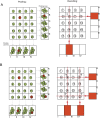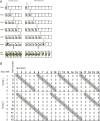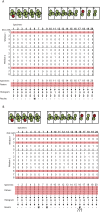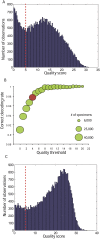DNA Sudoku--harnessing high-throughput sequencing for multiplexed specimen analysis
- PMID: 19447965
- PMCID: PMC2704425
- DOI: 10.1101/gr.092957.109
DNA Sudoku--harnessing high-throughput sequencing for multiplexed specimen analysis
Abstract
Next-generation sequencers have sufficient power to analyze simultaneously DNAs from many different specimens, a practice known as multiplexing. Such schemes rely on the ability to associate each sequence read with the specimen from which it was derived. The current practice of appending molecular barcodes prior to pooling is practical for parallel analysis of up to many dozen samples. Here, we report a strategy that permits simultaneous analysis of tens of thousands of specimens. Our approach relies on the use of combinatorial pooling strategies in which pools rather than individual specimens are assigned barcodes. Thus, the identity of each specimen is encoded within the pooling pattern rather than by its association with a particular sequence tag. Decoding the pattern allows the sequence of an original specimen to be inferred with high confidence. We verified the ability of our encoding and decoding strategies to accurately report the sequence of individual samples within a large number of mixed specimens in two ways. First, we simulated data both from a clone library and from a human population in which a sequence variant associated with cystic fibrosis was present. Second, we actually pooled, sequenced, and decoded identities within two sets of 40,000 bacterial clones comprising approximately 20,000 different artificial microRNAs targeting Arabidopsis or human genes. We achieved greater than 97% accuracy in these trials. The strategies reported here can be applied to a wide variety of biological problems, including the determination of genotypic variation within large populations of individuals.
Figures





Similar articles
-
Cloning the mouse homolog of the human cystic fibrosis transmembrane conductance regulator gene.Genomics. 1991 Jun;10(2):301-7. doi: 10.1016/0888-7543(91)90312-3. Genomics. 1991. PMID: 1712752
-
Comparison of next generation sequencing technologies for transcriptome characterization.BMC Genomics. 2009 Aug 1;10:347. doi: 10.1186/1471-2164-10-347. BMC Genomics. 2009. PMID: 19646272 Free PMC article.
-
Insertion of natural intron 6a-6b into a human cDNA-derived gene therapy vector for cystic fibrosis improves plasmid stability and permits facile RNA/DNA discrimination.J Gene Med. 1999 Sep-Oct;1(5):312-21. doi: 10.1002/(SICI)1521-2254(199909/10)1:5<312::AID-JGM55>3.0.CO;2-#. J Gene Med. 1999. PMID: 10738548
-
Microarray analysis in cystic fibrosis.J Cyst Fibros. 2004 Aug;3 Suppl 2:29-33. doi: 10.1016/j.jcf.2004.05.006. J Cyst Fibros. 2004. PMID: 15463921 Review.
-
Solid phase fluorescent sequencing of the CFTR gene.Methods Mol Biol. 2001;167:63-88. doi: 10.1385/1-59259-113-2:063. Methods Mol Biol. 2001. PMID: 11265322 Review. No abstract available.
Cited by
-
Rare variant association testing under low-coverage sequencing.Genetics. 2013 Jul;194(3):769-79. doi: 10.1534/genetics.113.150169. Epub 2013 May 1. Genetics. 2013. PMID: 23636738 Free PMC article.
-
Comprehensive Functional Analysis of the Enterococcus faecalis Core Genome Using an Ordered, Sequence-Defined Collection of Insertional Mutations in Strain OG1RF.mSystems. 2018 Sep 11;3(5):e00062-18. doi: 10.1128/mSystems.00062-18. eCollection 2018 Sep-Oct. mSystems. 2018. PMID: 30225373 Free PMC article.
-
Pool deconvolution approach for high-throughput gene mining from Bacillus thuringiensis.Appl Microbiol Biotechnol. 2018 Feb;102(3):1467-1482. doi: 10.1007/s00253-017-8633-6. Epub 2017 Nov 25. Appl Microbiol Biotechnol. 2018. PMID: 29177935
-
Generalized DNA barcode design based on Hamming codes.PLoS One. 2012;7(5):e36852. doi: 10.1371/journal.pone.0036852. Epub 2012 May 17. PLoS One. 2012. PMID: 22615825 Free PMC article.
-
Using next-generation sequencing for high resolution multiplex analysis of copy number variation from nanogram quantities of DNA from formalin-fixed paraffin-embedded specimens.Nucleic Acids Res. 2010 Aug;38(14):e151. doi: 10.1093/nar/gkq510. Epub 2010 Jun 4. Nucleic Acids Res. 2010. PMID: 20525786 Free PMC article.
References
-
- Andrews GE. Number theory. Dover; New York: 1994. Solving congruences; pp. 58–75.
-
- Bruno WJ, Knill E, Balding DJ, Bruce DC, Doggett NA, Sawhill WW, Stallings RL, Whittaker CC, Torney DC. Efficient pooling designs for library screening. Genomics. 1995;26:21–30. - PubMed
-
- Cleary MA, Kilian K, Wang Y, Bradshaw J, Cavet G, Ge W, Kulkarni A, Paddison PJ, Chang K, Sheth N, et al. Production of complex nucleic acid libraries using highly parallel in situ oligonucleotide synthesis. Nat Methods. 2004;1:241–248. - PubMed
-
- Cormen TC, Leiserson CE, Rivest RL, Stein C. Introduction to algorithms. 2nd ed. MIT Press; Cambridge, MA: 2001. Number theoretic algorithms; pp. 849–905.
Publication types
MeSH terms
Substances
LinkOut - more resources
Full Text Sources
Other Literature Sources
